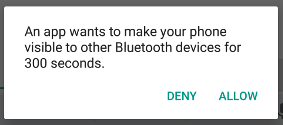使用 BluetoothAdapter,您可以通过设备发现或查询配对设备列表来查找远程蓝牙设备。
在尝试查找蓝牙设备之前,请确保您具有适当的蓝牙权限并为您的应用设置蓝牙。
设备发现是一种扫描过程,用于搜索本地区域内的支持蓝牙的设备并请求获取每个设备的一些信息。此过程有时称为发现、查询或扫描。附近的蓝牙设备仅在其当前允许信息请求(即处于可发现状态)时才会响应发现请求。如果设备可发现,则会通过共享一些信息(例如设备名称、类别及其唯一的 MAC 地址)来响应发现请求。使用这些信息,执行发现过程的设备可以选择发起与已发现设备的连接。
由于可发现设备可能会泄露用户位置信息,因此设备发现过程需要位置访问权限。如果您的应用在运行 Android 8.0(API 级别 26)或更高版本的设备上使用,请考虑改用伴侣设备管理器 API。此 API 会代表您的应用执行设备发现,因此您的应用无需请求位置权限。
首次与远程设备建立连接后,系统会自动向用户显示配对请求。设备配对后,有关该设备的基本信息(例如设备名称、类别和 MAC 地址)会保存下来,可以使用蓝牙 API 读取这些信息。使用已知远程设备的 MAC 地址,可以在任何时候发起连接,而无需执行发现,前提是该设备仍在范围内。
请注意,配对和连接是不同的概念。
- 配对是指两个设备彼此知道对方的存在,共享一个可用于身份验证的链接密钥,并能够相互建立加密连接。
- 连接是指设备当前共享一个 RFCOMM 通道并能够相互传输数据。当前的蓝牙 API 要求设备在建立 RFCOMM 连接之前进行配对。使用蓝牙 API 发起加密连接时,会自动执行配对。
以下部分介绍了如何查找已配对的设备以及如何使用设备发现来发现新设备。
查询配对设备
在执行设备发现之前,值得查询配对设备集,以查看所需的设备是否已知。为此,请调用 getBondedDevices()。这将返回一组表示配对设备的 BluetoothDevice 对象。例如,您可以查询所有配对设备并获取每个设备的名称和 MAC 地址,如下面的代码片段所示
Kotlin
val pairedDevices: Set<BluetoothDevice>? = bluetoothAdapter?.bondedDevices pairedDevices?.forEach { device -> val deviceName = device.name val deviceHardwareAddress = device.address // MAC address }
Java
Set<BluetoothDevice> pairedDevices = bluetoothAdapter.getBondedDevices(); if (pairedDevices.size() > 0) { // There are paired devices. Get the name and address of each paired device. for (BluetoothDevice device : pairedDevices) { String deviceName = device.getName(); String deviceHardwareAddress = device.getAddress(); // MAC address } }
要发起与蓝牙设备的连接,关联的 BluetoothDevice 对象所需的全部信息是 MAC 地址,您可以通过调用 getAddress() 来检索该地址。您可以在连接蓝牙设备中详细了解如何创建连接。
发现设备
要开始发现设备,请调用 startDiscovery()。该过程是异步的,并返回一个布尔值,指示发现是否已成功开始。发现过程通常包括大约 12 秒的查询扫描,然后对找到的每个设备进行页面扫描以检索其蓝牙名称。
要接收有关每个已发现设备的信息,您的应用必须为 ACTION_FOUND intent 注册一个 BroadcastReceiver。系统会为每个设备广播此 intent。该 intent 包含额外的字段 EXTRA_DEVICE 和 EXTRA_CLASS,它们分别包含一个 BluetoothDevice 和一个 BluetoothClass。以下代码片段展示了如何在发现设备时注册处理广播
Kotlin
override fun onCreate(savedInstanceState: Bundle?) { ... // Register for broadcasts when a device is discovered. val filter = IntentFilter(BluetoothDevice.ACTION_FOUND) registerReceiver(receiver, filter) } // Create a BroadcastReceiver for ACTION_FOUND. private val receiver = object : BroadcastReceiver() { override fun onReceive(context: Context, intent: Intent) { val action: String = intent.action when(action) { BluetoothDevice.ACTION_FOUND -> { // Discovery has found a device. Get the BluetoothDevice // object and its info from the Intent. val device: BluetoothDevice = intent.getParcelableExtra(BluetoothDevice.EXTRA_DEVICE) val deviceName = device.name val deviceHardwareAddress = device.address // MAC address } } } } override fun onDestroy() { super.onDestroy() ... // Don't forget to unregister the ACTION_FOUND receiver. unregisterReceiver(receiver) }
Java
@Override protected void onCreate(Bundle savedInstanceState) { ... // Register for broadcasts when a device is discovered. IntentFilter filter = new IntentFilter(BluetoothDevice.ACTION_FOUND); registerReceiver(receiver, filter); } // Create a BroadcastReceiver for ACTION_FOUND. private final BroadcastReceiver receiver = new BroadcastReceiver() { public void onReceive(Context context, Intent intent) { String action = intent.getAction(); if (BluetoothDevice.ACTION_FOUND.equals(action)) { // Discovery has found a device. Get the BluetoothDevice // object and its info from the Intent. BluetoothDevice device = intent.getParcelableExtra(BluetoothDevice.EXTRA_DEVICE); String deviceName = device.getName(); String deviceHardwareAddress = device.getAddress(); // MAC address } } }; @Override protected void onDestroy() { super.onDestroy(); ... // Don't forget to unregister the ACTION_FOUND receiver. unregisterReceiver(receiver); }
要发起与蓝牙设备的连接,请在 BluetoothDevice 上调用 getAddress() 以检索关联的 MAC 地址。
启用可发现性
要使本地设备可被其他设备发现,请使用 ACTION_REQUEST_DISCOVERABLE intent 调用 startActivityForResult(Intent, int)。这将发出请求以启用系统的可发现模式,而无需导航到“设置”应用(这会停止您自己的应用)。默认情况下,设备可发现两分钟。您可以通过添加 EXTRA_DISCOVERABLE_DURATION extra 来定义不同的持续时间,最长可达五分钟。
以下代码片段将设备设置为可发现五分钟
Kotlin
val requestCode = 1; val discoverableIntent: Intent = Intent(BluetoothAdapter.ACTION_REQUEST_DISCOVERABLE).apply { putExtra(BluetoothAdapter.EXTRA_DISCOVERABLE_DURATION, 300) } startActivityForResult(discoverableIntent, requestCode)
Java
int requestCode = 1; Intent discoverableIntent = new Intent(BluetoothAdapter.ACTION_REQUEST_DISCOVERABLE); discoverableIntent.putExtra(BluetoothAdapter.EXTRA_DISCOVERABLE_DURATION, 300); startActivityForResult(discoverableIntent, requestCode);

图 2:启用可发现性对话框。
系统会显示一个对话框,请求用户允许设备可发现,如图 2 所示。如果用户响应“允许”,则设备在指定的时间内可发现。然后,您的 activity 会收到对 onActivityResult() 回调的调用,结果代码等于设备可发现的持续时间。如果用户响应“拒绝”或发生错误,则结果代码为 RESULT_CANCELED。
设备在分配的时间内静默保持在可发现模式。要在可发现模式更改时收到通知,请为 ACTION_SCAN_MODE_CHANGED intent 注册一个 BroadcastReceiver。此 intent 包含额外的字段 EXTRA_SCAN_MODE 和 EXTRA_PREVIOUS_SCAN_MODE,它们分别提供了新旧扫描模式。每个 extra 的可能值如下所示
SCAN_MODE_CONNECTABLE_DISCOVERABLE- 设备处于可发现模式。
SCAN_MODE_CONNECTABLE- 设备未处于可发现模式,但仍可接收连接。
SCAN_MODE_NONE- 设备未处于可发现模式,也无法接收连接。
如果您正在发起与远程设备的连接,则无需启用设备可发现性。仅当您希望您的应用托管一个接受传入连接的服务器套接字时才需要启用可发现性,因为远程设备必须能够在发起与其他设备的连接之前发现这些设备。
